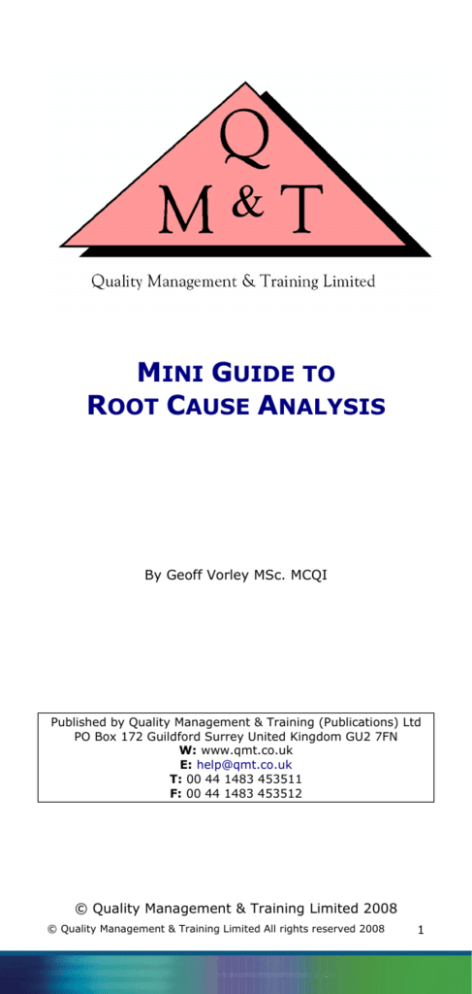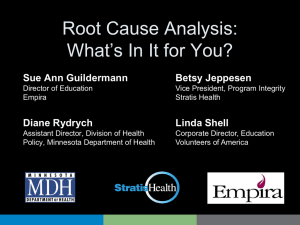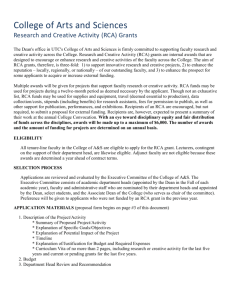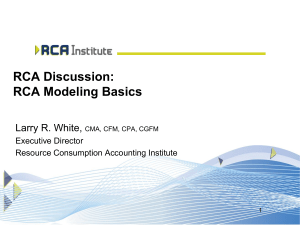
MINI GUIDE TO
ROOT CAUSE ANALYSIS
By Geoff Vorley MSc. MCQI
Published by Quality Management & Training (Publications) Ltd
PO Box 172 Guildford Surrey United Kingdom GU2 7FN
W: www.qmt.co.uk
E: help@qmt.co.uk
T: 00 44 1483 453511
F: 00 44 1483 453512
© Quality Management & Training Limited 2008
© Quality Management & Training Limited All rights reserved 2008
1
MINI GUIDE TO
ROOT CAUSE ANALYSIS
Contents:
1)
2)
3)
4)
5)
6)
7)
8)
9)
Introduction .................................................. 3
Why complete Root Cause Analysis? ................. 4
QM&T approach to RCA................................... 5
Practical guide to carrying out an RCA. ............. 6
RCA Tools & Techniques.................................. 7
Look up table for completing an RCA .............. 13
Examples RCA’s ........................................... 14
Hints and Tips ............................................. 14
12 Pitfalls of RCA ......................................... 14
© Quality Management & Training Limited All rights reserved 2008
2
MINI GUIDE TO ROOT CAUSE ANALYSIS
1)
Introduction
Root Cause Analysis (RCA) is a method that is used to address
a problem or non-conformance, in order to get to the “root
cause” of the problem. It is used so we can correct or eliminate
the cause, and prevent the problem from recurring.
It is not “rocket science” – anyone can do it. You probably do it
on a day to day basis without thinking about it.
RCA is simply the application of a series of well known,
common sense techniques which can produce a systematic,
quantified and documented approach to the identification,
understanding and resolution of underlying causes. Below are
a number of definitions which encapsulates the main points of
this technique:
Identify the
Problem
Monitor the
system
Define the
Problem
Corrective
action
Understand
the problem
Identify the
root cause
“An objective, thorough and disciplined methodology employed
to determine the most probable underlying causes of problems,
complaints and undesired events within an organization, with
the aim of formulating and agreeing corrective actions to at
least mitigate, if not eliminate, those causes and so produce
significant long term performance improvement.” - Vorley &
Tickle, QM&T, 2002
“A powerful tool used to identify, record and visually represent
the possible causes of a problem” Instead of problems and their
effects appearing vast and insoluble, root cause analysis breaks
down the problem into smaller, more easily handled chunks
represented by a ‘fishbone’ diagram”. - Paul Wilson RCA
(ASQC)
“The investigation and reporting the causes of occurrences to
enable the identification of corrective actions adequate to
prevent recurrence and thereby protect the health and safety of
the public, the workers, and the environment.” - RCA Guidance
document DOE Guidelines, Feb 92
© Quality Management & Training Limited All rights reserved 2008
3
MINI GUIDE TO ROOT CAUSE ANALYSIS
2)
Why complete Root Cause Analysis?
Organizations often respond to problems with short-term
solutions. However, constantly relying on quick fixes requires
staff to repeat the same tasks over and over again, all while
maintaining the status quo. Focusing on short-term solutions is
not a recipe for increased profitability and organizational
growth.
When people spend a lot of time putting out fires in the
workplace, there is an illusion of industry; lots of busy people
completing lots of tasks. Working harder and faster, we allow
the environment’s energy and rhythm to seduce us into
believing we’re doing our best to increase productivity and
efficiency. But the law of diminishing returns applies here.
However, you can improve efficiency by taking time to think
through problems from first principles, and then tackling the
causes rather than the effects.
To improve efficiency and profitability, we need to look beneath
the surface to the root of a problem or issue. By observing the
effect (which is really just the symptom) of a problem and
deducing what has caused it to occur, you can create a
preventative solution that should put an end to the problem. In
order to understand the source of a problem, you will need to
undertake a root cause analysis.
RCA gives the confidence that the problem can be solved by
taking a structured approach - making sure that the problem
never happens again.
•
By the way, RCA is not a chore – it can be fun!
•
By eliminating the root cause, you can save time and
money
© Quality Management & Training Limited All rights reserved 2008
4
MINI GUIDE TO ROOT CAUSE ANALYSIS
3)
QM&T approach to RCA.
The first step in any RCA is to identify the problem. QM&T
monitor many aspects of the organisation, and can spot
potential problem areas. This process is known as Pareto
Analysis, which we will cover later. However, potential RCA’s
can be derived from many areas, ranging from Customer
Complaints, Escalations, and Incidents through to recurring
EARS/QA’s, Customer Surveys and Credit Notes.
The Corrective Action Request (CAR) system can be used to
document the immediate and longer term corrective action.
There is no one person identified to chase and progress these
CAR. This pocket guide is not intended to be a guide to the
CAR system, but to provide a ‘Road Map’ or approach that can
be adopted in tackling a specific RCA project. The table below
may help in determining the RCA projects importance.
RCA Significance
Consequences or Severity of Incident
Likelihood
of
Occurrence
Almost
certain
Likely
Possible
Unlikely
Rare
Critical
High
Medium
Low
Very high
risk
Very high
risk
Very high
risk
High Risk
Low Risk
High Risk
Moderate
Risk
Moderate
Risk
High Risk
Moderate
Risk
Moderate
Risk
Moderate
Risk
Low Risk
Low Risk
Low Risk
Very Low
Risk
Low Risk
Low Risk
Very Low
Risk
Very Low
Risk
Consequences (of incident): Critical: Health & Safety issue,
High: Customer’s Business Process (CBP) unavailable, Medium:
Customer’s Business Process (CBP) degraded, Low: Non urgent
Likelihood (of occurrence): Almost certain, Likely, Possible,
Unlikely, Rare
Priority: Very High Risk, High Risk, Moderate Risk, Low Risk,
Very Low Risk
© Quality Management & Training Limited All rights reserved 2008
5
MINI GUIDE TO ROOT CAUSE ANALYSIS
4)
Practical guide to carrying out an RCA.
To assist with the process, QM&T have devised a Worksheet
which can be found at on the website, along with many if the
tools that can be used to complete a RCA project. Once the
problem has been discovered there are 5 basic steps to
completing an RCA.
5. Confirm
the Solution
1. Define the
Problem
4. Corrective
Action
2. Understand
the Problem
3.
Immediate
Action
I.
Define the Problem: Try and use SMART principles, i.e.
Specific; Measurable, Actions oriented; Realistic; Time
constrained. Unless the problem is defined accurately, the
RCA whole process maybe prone to failure. This phase will
usually also define how the RCA will be run as a Project.
II. Understand the Problem: Check the information,
obtaining real data regarding the problem, gaining a clear
understanding of the issues. This is when the various tools
and techniques, such as Cause and Effect, brainstorming,
etc, can be used.
III. Immediate Action: Implement temporary countermeasures at the place of the problem. ‘The further away
from the problem source the solution is determined, the
less likely that the solution will be effective’.
IV. Corrective Action: Determine and prioritise the most
probable underlying causes of the problem, as the
temporary counter-measure may not resolve the root
cause. Taking corrective actions to at least mitigate or
preferably eliminate the causes.
V.
Confirm the Solution:. After the measures have been
determined and implemented the success of the adopted
approach needs to be established. Having confirmed the
success of the suggested solution then rules or control
methods need to be established that will avoid the
problem ever happening again. . This is probably the
most important phase in the RCA, but the one most
often missed.
© Quality Management & Training Limited All rights reserved 2008
6
MINI GUIDE TO ROOT CAUSE ANALYSIS
5)
RCA Tools & Techniques.
5 Why’s (or Gemba Gembutsu)
5 Why’s can sometimes be referred to as Gemba Gembutsu
(which literally means Place and Information in Japanese, from
who’s car industry much of today’s RCA methods are taken). 5
Why's typically refers to the practice of asking, five times, why
the failure has occurred in order to get to the root cause/causes
of the problem. No special technique is required or form is
required, but the results should be captured in the Worksheet
(see an example of 5 Why’s in Sect.6). 5 Why’s are best used
when tackling a simple RCA.
Pareto Analysis
Pareto analysis is an easy to use technique that helps you to
choose the most effective changes to make.
It uses the Pareto principle, i.e. the idea that by doing 20% of
the work you can generate 80% of the advantage of doing the
entire job. Pareto analysis is a formal technique for finding the
changes that will give the biggest benefits. It is useful where
many possible courses of action are competing for your
attention.
For example, you might want to establish why customers no
longer deal with us as a supplier.
Number of Customers
Study of Customer Satisfaction
'
20% of the
Problem
80
70
60
50
80% of the
Quantity or Cost
The graph reveals approx. 20% of
reasons for leaving are responsible
for 80% of the customers who left
40
30
20
10
R
ea
so
n
ic
e
Reason for Leaving
N
o
Pr
Su
pp
lie
rs
io
n
O
th
er
pe
tit
n
C
om
fa
ct
io
at
is
D
is
s
At
tit
ud
e
of
In
di
ffe
nc
e
0
# of Customers
© Quality Management & Training Limited All rights reserved 2008
7
MINI GUIDE TO ROOT CAUSE ANALYSIS
Cause & Effect diagrams
Also known as Fishbone diagrams (for their appearance) and
Ishikawa diagrams(names after their developer Kaoru
Ishikawa), this useful technique is used for more complex
RCAs.
This type of diagram identifies ALL the potential
processes and factors that could contribute to a problem. A
basic diagram is shown below. A basic Cause and Effect
template can be found in Microsoft Visio, or just use
PowerPoint.
Materials
Men
Cause 1
Cause 1
Equipment
Cause 2
Cause 2
Cause 3
Cause 2
Cause 3
Cause 3
Cause 1
Cause 1
Effect
Cause 1
Measurement
Cause 1
Cause 1
Cause 1
Environment
Cause 2
Process or Method
Once you have captures all the desired information, try and
prioritise those areas that you have a control over, and
concentrate on finding resolutions for these.
Brainstorming/Interviewing
Most people are familiar with Brainstorming and Interviewing
techniques. However, here are a few reminders:
•
Collect as many ideas as possible from all participants with
no criticisms or judgments made while ideas are being
generated.
•
All ideas are welcome no matter how silly or far out they
seem. Be creative. The more ideas the better because at
this point you don't know what might work.
•
No secondary discussions should take place during the
brainstorming activity. Talking about the ideas will take
place after brainstorming is complete.
•
Do not criticize or judge. Don't even groan, frown, or
laugh. All ideas are equally valid at this point.
•
Do build on others' ideas.
•
Do write all ideas on a flipchart or board so the whole
group can easily see them.
Use Cause and Effect
Diagrams and Fault Trees to help capture the
information.
•
Set a time limit for the brainstorming. 30 minutes is often
enough.
© Quality Management & Training Limited All rights reserved 2008
8
MINI GUIDE TO ROOT CAUSE ANALYSIS
Process Analysis, Mapping and flowcharts
Credit
Problem
Addressed
OK ?
No
Order
Stopped
Product
Order
Completed
Process Payment
Invoice
Customer
Order
Generated
Sales
Most processes we follow today are mapped out by a flowchart.
Flowcharts organize information about a process in a graphical
manner thus making it clear what is impacted. Whether your
problem has a documented process or not, this can be a really
useful tool to understand what is going on. You don’t have to
be an expert to in flowcharting either. Although there are
good templates in Microsoft PowerPoint and Visio, you can just
as easily use a wipe board or pen and paper.
Production
Control
Credit &
Invoicing
Yes
No
Order
Received
Check
Credit
OK ?
Yes Credit
OK
Order
Entered
Invoice
Prepared
In
Stock?
Shipped
Order ?
Invoice
Sent
No
Assembly &
Shipping
Copying
Yes
Production
Scheduled
Diskettes
Copied
Packages
Assembled
Order
Picked
Order
Shipped
© Quality Management & Training Limited All rights reserved 2008
9
MINI GUIDE TO ROOT CAUSE ANALYSIS
Fault Tree
This is a graphical technique that provides a systematic
description of the combinations of possible occurrences in a
system, which can result in an undesirable outcome. This
method can combine system and human failures
A good
example is shown below.
Fault trees can either be presented left to right or top to
bottom. There are many specialist software products that allow
Fault Tree analysis, but both Microsoft PowerPoint and Visio can
be used to complete these diagrams.
© Quality Management & Training Limited All rights reserved 2008
10
MINI GUIDE TO ROOT CAUSE ANALYSIS
Check Sheets
Check Sheets (or Tally Charts) are simply used to gather and
record data. The data is usually numerical, but can also be
used for other purposes, e.g. listing audit questions to be asked
and recording the responses. You may use a Check Sheet on a
day-to-day basis to check for software defects or the numbers
and types of Customer incidents.
Example 1 – Study of projects completed late
#
1
2
3
4
5
6
Checked
Project Number
1
2
3
Correct File
2
Structure/Contents
Specification
3
correct
Cost estimate
3
available
Customer Order
3
available
Order
3
Acknowledged
Contract reviewed
3
Total correct
5
4
5
Number %
correct Failure
2
2
2
2
0
100
2
2
2
2
1
80
3
3
2
2
3
40
3
3
2
2
3
40
3
3
2
2
3
40
2
3
2
2
2
60
3
4
0
0
Example 2 – Study of customers reasons for leaving
Customer
Number per month
Relationship
Week
Total
M
J
J
A
S
No reason
11
1111
1111
1
111
17
Other
suppliers
11
1111
1
1111 1
11
15
1
1
1
1111
11
10
1111
1
1111 1
0
1111
1111
111
24
9
10
15
12
20
66
Competitive
Reasons
Attitude of
staff
Total
© Quality Management & Training Limited All rights reserved 2008
11
MINI GUIDE TO ROOT CAUSE ANALYSIS
Sampling
Used to collect data for the above check sheets
Control Charts
The control chart is a graph used to study how a process
changes over time. Data is plotted in time order. A control
chart has a central line for the average, an upper line for the
upper control limit and a lower line for the lower control limit.
These lines are determined from historical data. By comparing
current data to these lines, you can draw conclusions about
whether the process variation is consistent (in control) or is
unpredictable (out of control, affected by special causes of
variation).
We quite often use Control Charts to look at where areas of the
Business are falling outside defined limits. For example, when
the number of reported incidents exceeds a certain figure.
Example of Help Desk Calls
Quality Planning
Every stage of a process or project is a possible source of poor
quality. The objective of a Quality Plan is to anticipate possible
sources of poor quality and to arrange for means of identifying
such failure and preventing them from occurring. Where a
Quality Manual is company specific a Quality Plan is project or
process specific.
© Quality Management & Training Limited All rights reserved 2008
12
MINI GUIDE TO ROOT CAUSE ANALYSIS
Brain Storming (NGT)
●
Cause and Effect
Dgrms
●
●
●
Check Sheets
●
●
Gemba Gembutsu 5whys
●
5. Confirm the Solution
(Monitor Action Plan)
●
●
4. Corrective Action
(Implement Action Plan)
2. Understand the Problem
(Data Analysis)
●
3. Immediate Action
(Develop Action Plan)
2. Understand the Problem
(Collect Data)
Activity Sampling
2. Understand the Problem
(Evaluate Improvement Area)
Section (See “Quality
Management - Tools
& Techniques”)
1. Define the Problem
(Identify Improvement Area)
6) Look up table for completing an RCA
●
●
●
Histograms
●
Pareto Analysis
●
Performance
Measurem’t
●
●
●
Process Mapping
●
●
●
●
●
●
Quality Planning
●
Risk Assessment
(FMEA)
●
●
Root Cause Analysis
●
●
Sampling
●
●
●
●
●
●
●
●
●
●
●
Scatter Diagrams
●
Six Sigma
●
SMART
●
Statistical Quality
Control
●
●
●
●
●
●
●
© Quality Management & Training Limited All rights reserved 2008
●
13
MINI GUIDE TO ROOT CAUSE ANALYSIS
7)
Examples RCA’s
Examples of RCA projects will be shown on the RCA course.
8)
Hints and Tips
•
It is important to select the right team for carrying out an
RCA; members should have knowledge of the process and
be able to help explore the why, what and how
•
Don't jump in with solutions: the problem and solution
may not be obvious
•
Make sure you are aware of the causal relationships
•
Suggest improvements that you can implement and that
•
Having a facilitator with experience in the process will
are owned and signed up to by your team
make things easier; this includes someone who knows
about process, tools and facilitation
•
Practising the techniques of RCA will ensure that your
maintain the skills
•
Only take responsibility for actions over which you have
control: you should not agree an action plan for something
you can't implement
9)
i.
ii.
iii.
iv.
v.
vi.
vii.
viii.
ix.
x.
xi.
xii.
12 Pitfalls of RCA
Not understanding the problem and therefore not defining
it correctly
Not asking for help
Not considering all possible failure modes/causes
Not identifying all root causes
Not understanding how the system should operate
Runaway tests and analysis
Adopting a 'remove & replace' mentality
Silver Bullet Theory
Returning the part/product without analysis
Failing to follow-through
Jumping to conclusions (satisficing)
Tearing a system apart without a plan
Authors:
Geoff Vorley – Quality Management & Training Limited
Mary-Clare Bushell- Quality Management & Training Limited
© Quality Management & Training Limited All rights reserved 2008
14
MINI GUIDE TO ROOT CAUSE ANALYSIS
Quality Management & Training Limited
PO Box 172 Guildford Surrey United Kingdom GU2 7FN
T: +44 (0) 1483 453511
F: +44 (0) 1483 453512
E: help@qmt.co.uk
W: www.qmt.co.uk
First Published by Quality Management & Training Limited
2008
All rights reserved. No part of this publication may be
reproduced in any material form including photocopying,
or storing in any medium by electronic means and
whether or not transiently or incidentally to some other
use of this publication without the written permission of
the Copyright holder except in accordance with the
provision of the Copyright, Designs and Patents Act 1988
or under the terms of a licence issued by the Copyright
Licensing Agency Limited, 90 Tottenham Court Road,
London, W1P 9HE, England. Applications for copyright
holder’s permission to reproduce any part of this
publication should be addressed to the publishers.
© Quality Management & Training Limited All rights reserved 2008
15








